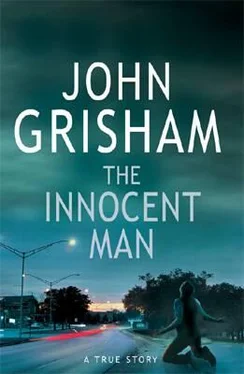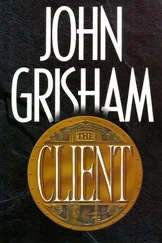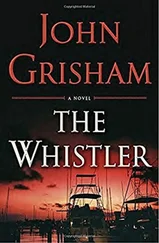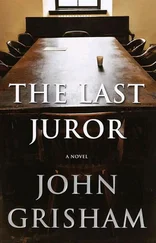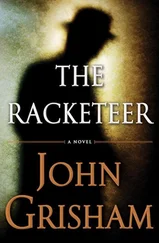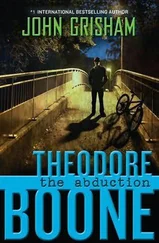The intense manhunt on Sunday produced nothing, not a single clue. Dennis Smith and Gary Rogers called it off after dark and made plans to reassemble early the next morning. On Monday, they obtained a college photograph of Denice and printed flyers with her pretty face and general descriptionfive feet five inches tall, 110 pounds, brown eyes, dark blond hair, light complexion. The flyer also listed a description of the two young men seen at JP's, along with one of the old pickup truck. These were placed in every store window in and around Ada by cops and volunteers.
A police artist worked with the clerk from JP's and put together two sketches. When the drawings were shown to the customer at McAnally's, he said that one of them was at least "in the ballpark." The two composites were given to the local television station, and when the town got its first look at the possible suspects, calls poured in to the police station.
Ada had four detectives at the time-Dennis Smith, Mike Baskin, D. W. Barrett, and James Fox-and they were soon overwhelmed with the number of calls. More than a hundred, with about twenty-five names given for potential suspects.
Two names stood out. Billy Charley was suggested by about thirty of the callers, so he was invited in for questioning. He arrived at the police station with his parents, who said that he had been at home with them throughout Saturday night.
The other name given by about thirty concerned citizens was that of Tommy Ward, a local boy the police knew well. Tommy had been arrested several times for misdemeanors-public drunkenness, petty theft-but nothing violent. He had family all over Ada, and the Wards were known as generally decent folks who worked hard and tended to their own business. Tommy was twenty-four years old, the second youngest of eight children, a high school dropout.
He voluntarily came in for questioning. Detectives Smith and Baskin asked him about last Saturday night. He'd been fishing with a friend, Karl Fontenot, then they'd gone to a party, stayed out until 4:00 a.m., then walked home. Tommy didn't own a vehicle. The detectives noticed that Ward's blond hair had been cut very short, a hack job that was uneven and obviously unprofessional. They took a Polaroid of the back of his head and dated it May 1.
The suspects in the composites both had long, light-colored hair.
Detective Baskin found Karl Fontenot, a man he did not know, and asked him to stop by the station for some questions. Fontenot agreed, but never arrived. Baskin didn't pursue it. Fontenot had long, dark hair.
As the search continued with great urgency in and around Ponto-toc County, Denice Haraway's name and description were broadcast to law enforcement officials nationwide. Calls came from everywhere, but not one was of any benefit. Denice had simply vanished without leaving a single clue.
When Steve Haraway wasn't handing out flyers or driving the back roads, he was secluded in his apartment with a few friends. The phone rang constantly, and with each call there was a moment of hope.
There was no reason for Denice to run away. They had been married less than a year and were still very much in love. Both were seniors at East Central, looking forward to graduation and leaving Ada for a life somewhere else. She had been taken against her will, he was certain of that.
Each passing day brought a greater likelihood that Denice would not be found alive. If she had been grabbed by a rapist, she would have been released after the assault. If she had been kidnapped, someone would have demanded a ransom. There were rumors of an old lover down in Texas, but they came and went. And there were rumors of drug traffickers and such, but then most bizarre crimes had a few of those.
Ada, again, was shocked by the crime. Debbie Carter had been murdered seventeen months earlier, and the town had just settled down from that nightmare. Now doors were locked and double-locked, curfews were tightened on teenagers, and there was a brisk run of gun sales at the local pawnshops. What was happening to the nice little college town with two churches on every corner?
Weeks passed, and life slowly returned to normal for most of Ada 's population. It was soon summertime and the kids were out of school. The rumors died down but didn't stop altogether. A suspect in Texas boasted of killing ten women, and the Ada police raced off to interview him. A woman's body was found in Missouri, with tattoos on her legs. Denice had no tattoos.
And so it went through the summer and into the fall. Not a single break or piece of evidence of any kind that would lead the police to the body of Denice Haraway. And no progress in the Carter investigation. With two sensational murders remaining unsolved, the atmosphere around the police department was heavy and strained. Long hours were worked, with nothing to show for the time. Old leads were reviewed and chased again, with the same results. The lives of Dennis Smith and Gary Rogers were consumed with the two murders.
For Rogers, the pressure was even worse. One year before the disappearance of Denice Haraway, a similar crime had been committed in Seminole, thirty miles north of Ada. An eighteen-year-old girl named Patty Hamilton was working at an all-night convenience store when she vanished. A customer walked in and found the store empty, the cash register cleaned out, two open soft drink cans on the counter, no sign of a struggle. Her locked car was found outside the store. She was gone without a clue, and for a year the police had assumed she'd been abducted and murdered.
The OSBI agent in charge of the Patty Hamilton case was Gary Rogers. Debbie Carter, Denice Haraway, Patty HamiltonAgent Rogers had the unsolved murders of three young women on his desk.
When Oklahoma was still a territory, Ada had a colorful and richly deserved reputation as an open haven for gunslingers and outlaws. Disputes were settled with six-shooters, and the quickest on the draw walked away with no fear of punishment from civil authorities. Bank robbers and cattle thieves drifted to Ada because it was still Indian territory and not a part of the States. Sheriffs, when they could be found, were no match for the professional criminals who settled in and around Ada.
The town's reputation for lawlessness changed dramatically in 1909, when the locals finally got fed up with living in fear. A respected rancher named Gus Bobbitt was gunned down by a professional killer hired by a rival landowner. The killer and three conspirators were arrested, and an epidemic of hanging fever swept through the town. Led by the Masons, the upstanding members of Ada, a lynch mob formed early on the morning of April 19, 1909. Forty members marched solemnly out of the Masonic Hall on Twelfth at Broadway in downtown Ada and arrived at the jail a few minutes later. They subdued the sheriff, yanked the four thugs out of their cells, and dragged them across the street to a livery stable that had been chosen for the occasion. Each of the four had his wrists and ankles bound with baling wire, then each was ceremoniously hanged.
Early the next morning a photographer set up his camera in the barn and took some pictures. One survived over the years, a faded black and white that clearly shows all four men suspended by their ropes, motionless, almost peaceful, and quite dead. Years later, the photo was reproduced on a postcard and handed out at the Chamber of Commerce office.
For decades, the lynchings were Ada 's proudest moment.
With the Carter case, Dennis Smith and Gary Rogers not only had an autopsy, hair samples, and "suspicious" polygraph exams but also were confident they had their killer.Ron Williamson was away for a spell doing time, but he would be back. They'd nail him sooner or later.
With Haraway, though, they had nothing-no body, no witnesses, not a single solid clue. The sketches by the police artist could realistically fit half the young men in Ada. The cops were due for a break.
Читать дальше
